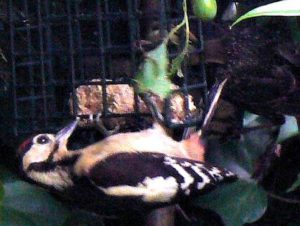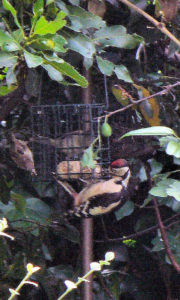This video is proof positive that having your camera, phonecam or vidcam to hand may help you capture the visit of an unusual visitor to your area – one who might have then flown on and never returned. Here, the pressing of a shutter has saved the moment – a woodland bird in a suburban London garden.
Before it was trashed by a developer, the little woodland behind our back gardens was visited by a great deal of wildlife, including The Great Spotted Woodpecker. This bird, one of over 180 Woodpecker species worldwide, is known for perching on the sides of trees, tapping on the bark until it finds a grub or some such creature beneath, & using its head like a jackhammer to drill a hole in the tree with its strong pointy beak & extract its protein meal.
Here in our garden this Woodpecker’s unexpected choice of food was suet – from a suetball feeder. The high def vidcam, a Canon Legria R306 set up on a tripod in the garden flat window, was activated when the bird appeared. When it returned a few days later to visit the treat block feeder, these stills were captured with the Lumix Panasonic DMC-TZ5 camera – taken from the top window in the house.
“The woodpecker’s strong, pointed beak acts as both a chisel and a crowbar to remove bark and find hiding insects. It has a very long tongue, up to four inches in some species – with a glue-like substance on the tip for catching insects.
While most birds have one toe pointing back & three pointing forward on each foot, woodpeckers have two sharply clawed toes pointing in each direction to help them grasp the sides of trees & balance while they hammer… Many woodpecker species also have stiffened tail feathers, which they press against a tree surface to help support their weight.”
http://www.defenders.org/woodpeckers/basic-facts
“The beak of the woodpeckers grows continuously. It is… used like a chisel. The beak hits the tree with a speed of 6-7 m (20-23 ft) per second, equaling 20 km (12 mi) per hour. The stop is instant. The slowdown at the impact is 1,000 times more powerful than the gravitational force, & about 100 times higher than the acceleration experienced by an astronaut during the launch of a spaceship. The brain of a woodpecker, that weighs a mere 2 to 4 grams, can stand the shock & the speed with which the blows of the head take place because of the large cranial surface (which distributes the shock evenly) and the stiff neck muscles which do not allow the twist of the neck.”
http://news.softpedia.com/news/4-Things-About-Woodpeckers-85218.shtml
The Great Spotted Woodpecker has not been spotted in or around our garden since these photos were taken. In place of the trees that were cut down we have, however, seen a number of developers and their minions over the years, salivating around the site of the little woodland & trying time & again to chivvy the Council into granting them planning permission to build there. (For our experience with developers, go to About on the drop-down menu.)
Remember, if there is a bit of undeveloped ground with mature trees in your area, don’t take it for granted. Watch out! A developer or architect may be about! Even the tiniest plot of scrub or vegetation being used by hard-pressed wildlife will be seen as a possible cash cow to a developer. Look into TPOs (Tree Protection Orders) & join with your community to safeguard as much of your local Nature as you can.

